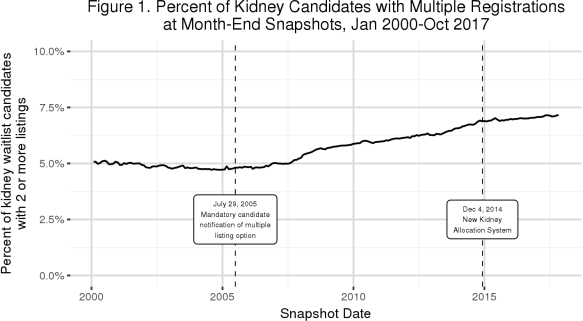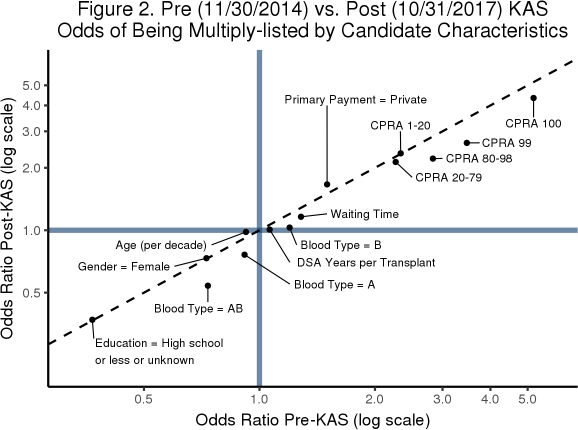Trends and Policy Influences on Multiple Listing Practices for Kidney Transplantation between 2000 and 2017
1Organ Transplantation, Scripps Green Hospital, La Jolla, CA
2United Network for Organ Sharing, Richmond, VA.
Meeting: 2018 American Transplant Congress
Abstract number: 389
Keywords: Kidney transplantation, Patient education, Public policy, Waiting lists
Session Information
Session Name: Concurrent Session: Regulatory Issues
Session Type: Concurrent Session
Date: Monday, June 4, 2018
Session Time: 4:30pm-6:00pm
 Presentation Time: 5:18pm-5:30pm
Presentation Time: 5:18pm-5:30pm
Location: Room 2AB
BACKGROUND: Organ allocation policies continually evolve to address long transplant wait times and a limited donor organ pool. Transplant candidates may list at multiple centers to increase the likelihood of receiving an organ. OBJECTIVE: To assess the impact of UNOS policy changes on the prevalence of multiple listing (ML) practices for kidney transplantation and associated candidate factors. METHODS: All kidney transplant candidates Jan 2000-Oct 2017 were identified as either singly or multiply listed using OPTN data. Temporal association between ML prevalence and known transplant policy changes were evaluated. Cross-sectional logistic regression was used to assess relationships between various candidate factors and ML. RESULTS: Average prevalence rates for kidney ML were 5.4% from 2000-2017 with a rise noted in 2005 following new policy requirements to educate candidates on the option of ML. Interestingly, this rise continued after implementation of the new kidney allocation system (KAS) in late 2014. Candidate factors associated with ML pre-KAS included blood type B (ref: type O; OR 1.20, p<0.001), private insurance (OR 1.5, p<0.0001), wait time (OR 1.28, p<0.001) and increasing CPRA (ref: CPRA 0; 80-98, OR 2.83; 99, OR 3.47; 100, 5.18; p<0.001). Candidates with high school education or less were less likely to ML (OR 0.37, p<0.001). A decrease in high CPRA and blood type B candidates were associated with ML after KAS. CONCLUSION: The decade-long rise in ML began when policy required patient notification of ML options and has not slowed with the newly implemented KAS. However, very highly sensitized candidates are less likely to be multi-listed post-KAS, perhaps due to increased access. Those with public insurance and without college education remain less likely to be ML. 

CITATION INFORMATION: Decoteau M., Stewart D., Toll A., Case J., Marsh C. Trends and Policy Influences on Multiple Listing Practices for Kidney Transplantation between 2000 and 2017 Am J Transplant. 2017;17 (suppl 3).
To cite this abstract in AMA style:
Decoteau M, Stewart D, Toll A, Case J, Marsh C. Trends and Policy Influences on Multiple Listing Practices for Kidney Transplantation between 2000 and 2017 [abstract]. https://atcmeetingabstracts.com/abstract/trends-and-policy-influences-on-multiple-listing-practices-for-kidney-transplantation-between-2000-and-2017/. Accessed December 13, 2025.« Back to 2018 American Transplant Congress
